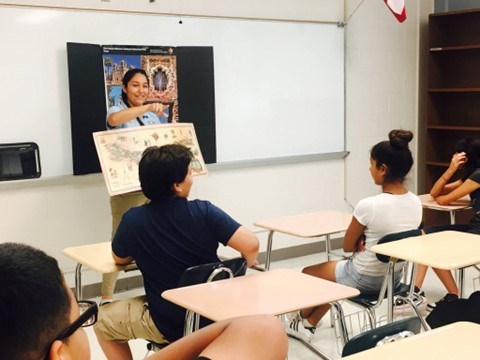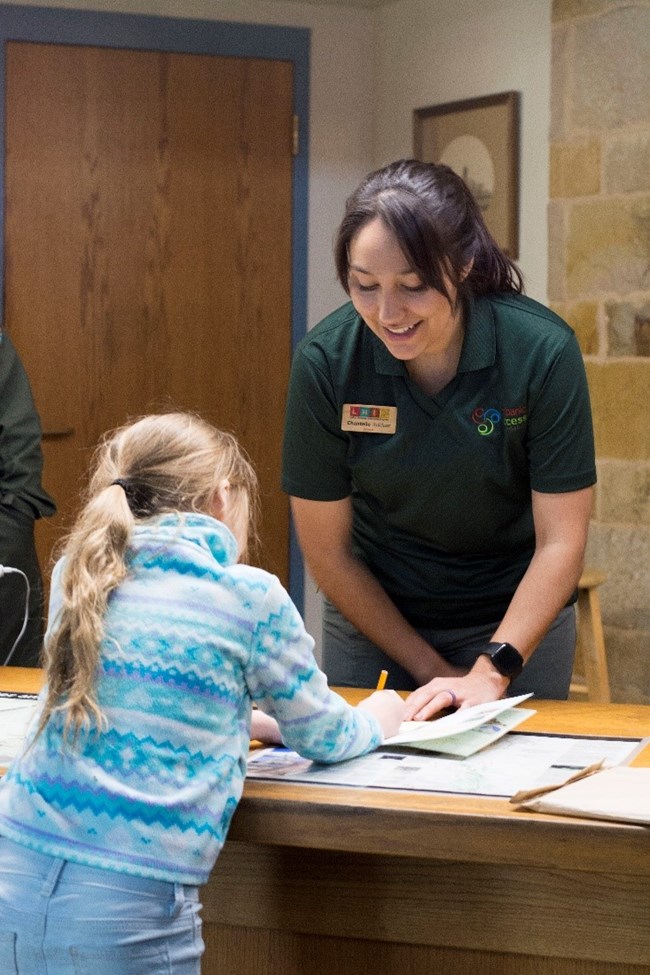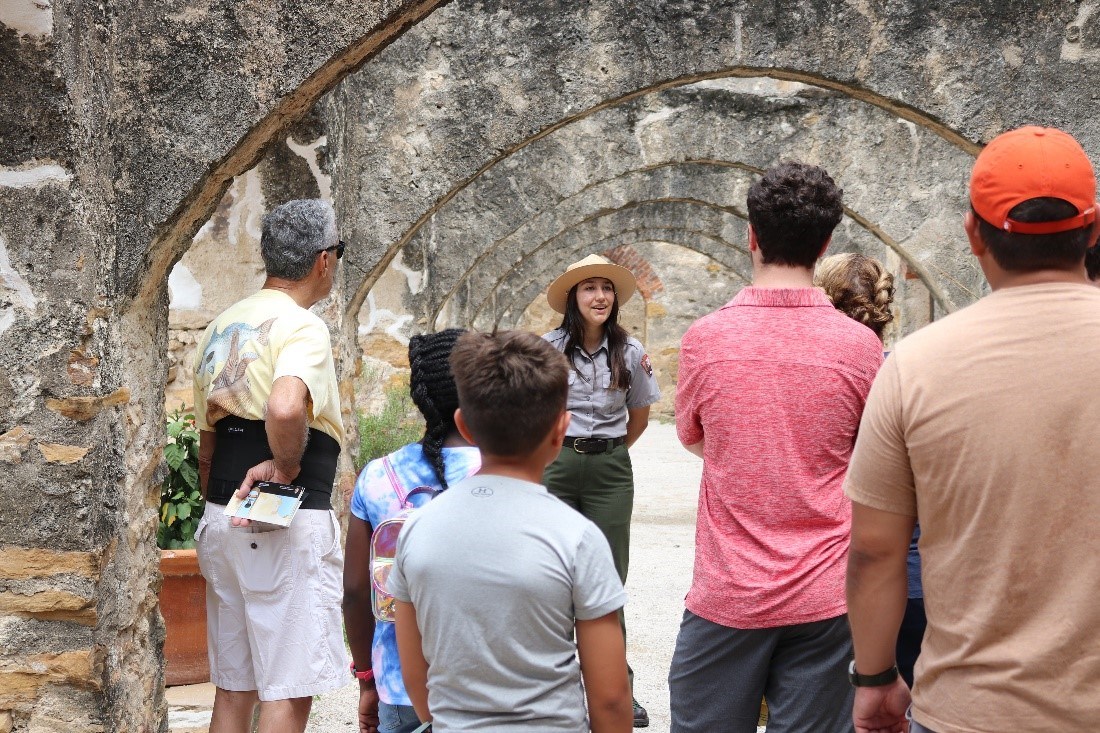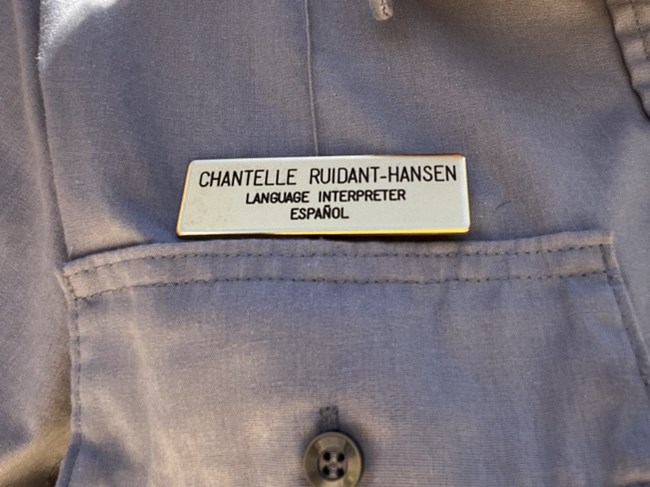Last updated: April 8, 2024
Article
Staff Spotlight: Chantelle Ruidant-Hansen

Photo Courtesy of Nick Wagner / San Antonio Report
What was your pathway to the NPS? Did you participate in an internship program?

NPS Photo
About seven years ago, in my university’s hallway, I saw a flyer casually taped to the wall announcing an opportunity for a paid summer internship. During my graduate studies in Cultural Anthropology, I applied for and was selected for the Latino Heritage Internship Program at San Antonio Missions National Historical Park. At that time, I did not know there was a national park in the city, or rather I did not understand what that meant and what the National Park Service was. Although I was lucky enough to travel, my family did not visit national parks like many families do. This internship was not only an introduction to what makes San Antonio Missions special, but to understanding the National Park Service and its mission.
After that summer working in community outreach and education under the inspiring park ranger and mentor Anna Martinez-Amos, I knew that it was something I was really interested in and could see myself doing but I did not know how. I returned to the park only a few months later, still in graduate school for anthropology to begin a long-term fellowship position through the Hispanic Access Foundation at San Antonio Missions National Historical Park. Throughout the fellowship, I continued learning about the park, the National Park Service, and what it meant to be an interpretive park ranger. In my fellowship role, I helped plan park events, attended outreach events, helped the interpretation division with front desk duties, and eventually gave tours of the park to both school children and adults. I loved that I could use my interest in anthropology, creativity, and nature all in one place.

NPS Photo
What do you do for the NPS?
In my current position as San Antonio Mission’s Visual Information Specialist, I manage the park’s website, social media, organize and manage the park’s photo and videos, design and print sign, flyers, publications and more. While it is sometimes designing and printing “Theatre Closed” or “Caution: Bees!” signs, it is also designing graphics for events, or even the park’s museum exhibits. I am currently working to finalize a new Junior Ranger book that I designed! The job can incorporate filming, photography and so much more depending on the park programs, but I find that communication skills are a must. It can be a lot of writing, especially for social media. As the Public Information Officer, I release information from the park to the media through press releases and interviews. Being the voice for the park to reporters both locally and worldwide has been an exciting challenge and opportunity.
To sum up what I do – I do media and communications.

NPS Photo
What do you find most rewarding about your job?
Being an interpretive park ranger is a very important job, and one that could have a lasting impact on thousands of visitors long-term. I take pride in telling the park’s story, both the amazing accomplishments of the past and the difficult realities of the history. I enjoy sharing the connections between our lives today with how it was formed by our historical past. I love helping others think about those connections. Some of the work I am most proud of has been helping people connect with the park to share their own stories. Working with the mission descendant community and helping lift those voices is especially rewarding. The digital exhibit “We’re Still Here” displays the work I did in 2019 to interview and photograph families with deep ties to the mission communities in San Antonio.
What does it mean to you to represent your community?

Photo Courtesy of Chantelle Ruidant-Hansen
As a Latina woman, with some of my own ancestral roots connecting to the larger park story, I feel a connection to what makes the park so important. San Antonio, Texas is also the largest majority, Hispanic city in the United States, and it is important that the population in the city sees themselves in the work that the National Park Service does to protect and preserve our parks. Being bilingual in Spanish is also a big piece of my work. I use it almost daily in the visitor center or online so that our content is not only accessible but inclusive to our community. Using the Spanish language is especially important in San Antonio Missions, since we tell the Spanish colonial story and how this history forever changed the local Indigenous population. The Spanish colonial mission history is the reason that many people in this region of the country speak Spanish today.
What are your hobbies?
I enjoy cooking, painting, drawing, going on walks, hiking, and gardening, However, taking most of my time at the moment is my son. I am a new mom; my son is just over one years old. It has been a huge transition caring for a child and continuing to work full time, but it has brought me so much joy.
